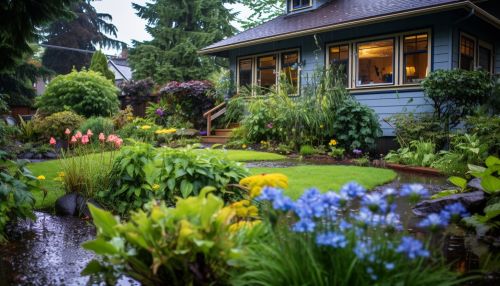Rain Gardens
Introduction
A rain garden is a planted depression or a hole that allows rainwater runoff from impervious urban areas, like roofs, driveways, walkways, parking lots, and compacted lawn areas, the opportunity to be absorbed. This reduces rain runoff by allowing stormwater to soak into the ground (as opposed to flowing into storm drains and surface waters which causes erosion, water pollution, flooding, and diminished groundwater). They can be designed for specific soils and climates.


Design and Construction
The design of a rain garden depends on several factors, including the size of the area it will serve, the type of soil, the local climate, and the types of plants that will be used. The construction process involves site selection, excavation, soil preparation, planting, and maintenance.
Site Selection
The site for a rain garden should be at least 10 feet away from the home to prevent water damage. It should also be placed in a naturally low spot in the yard, or where water tends to collect. The area should also receive full or partial sun.
Excavation
The depth of a rain garden can range from 4 to 8 inches for residential gardens, and up to 3 feet for larger, community-sized gardens. The size of the garden is typically about 20-30% of the area that drains into it.
Soil Preparation
The soil in a rain garden should be a mix of sand, compost, and topsoil. This type of soil, known as "bioretention soil," helps to filter pollutants from the water and promotes infiltration.
Planting
Plants in a rain garden should be able to tolerate both wet and dry conditions. Native plants are often the best choice, as they are adapted to local conditions and require less maintenance. The plants also help to filter pollutants from the water.
Maintenance
Maintenance of a rain garden involves regular weeding, watering during dry periods, and replacing any plants that do not survive.
Benefits
Rain gardens have many benefits, both for the environment and for homeowners. They help to reduce stormwater runoff, filter pollutants from the water, provide habitat for wildlife, and can be an attractive addition to the landscape.
Stormwater Management
Rain gardens are an effective way to manage stormwater runoff. By capturing and infiltrating stormwater, they reduce the amount of water that flows into storm drains and local water bodies.
Water Quality
Rain gardens help to improve water quality by filtering pollutants from stormwater runoff. The plants and soil in the garden help to remove nutrients, bacteria, and other pollutants from the water.
Wildlife Habitat
Rain gardens provide habitat for a variety of wildlife. They attract birds, butterflies, and beneficial insects, and can be a valuable addition to a wildlife-friendly garden.
Aesthetic Appeal
In addition to their environmental benefits, rain gardens can also be a beautiful addition to the landscape. With careful plant selection, they can provide year-round interest and color.
Challenges
While rain gardens have many benefits, they also present some challenges. These include the need for regular maintenance, potential for mosquito breeding, and the need for careful design to ensure effectiveness.
Maintenance
Regular maintenance is necessary to keep a rain garden functioning properly. This includes weeding, watering during dry periods, and replacing any plants that do not survive.
Mosquito Breeding
There is a potential for mosquito breeding in rain gardens, as they often contain standing water. However, this can be mitigated by ensuring that the garden drains within 24-48 hours, and by including plants that repel mosquitoes.
Design Challenges
Designing a rain garden can be challenging, as it requires a good understanding of the site conditions, including the type of soil, the amount of sun, and the size of the area that will drain into the garden.
